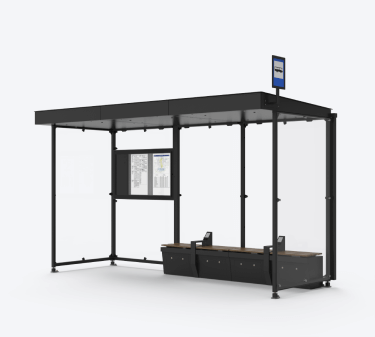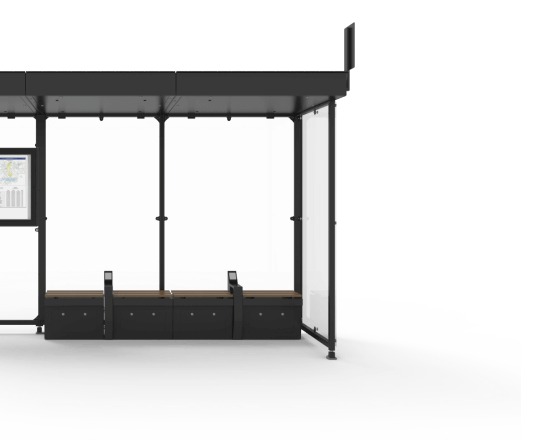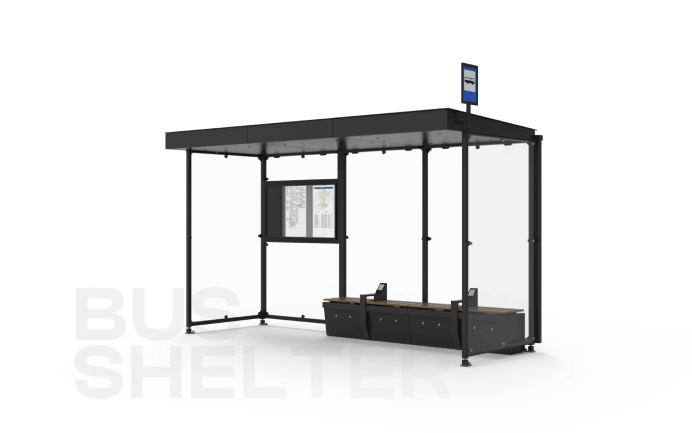Solar bus stops are energy-independent urban devices, performing information and multimedia functions for residents, as well as protecting against external urban factors. Thanks to a special controller for energy management and communication in the cloud, the bus shelter can work in the field all year round.
In the ever-evolving landscape of urban transit, smart solar bus shelters stand out as a key innovation, combining sustainability with modern convenience. These shelters are more than just a place for riders to wait for the bus—they’re a vital part of the transit system, providing power, lighting, and smart features that enhance the daily commute. This article will explore how solar bus shelters are transforming public transportation and why they are an essential component of a smart city’s infrastructure.



SEEDiA bus stops not only offers USB charging capabilities and an e-paper display powered by our custom energy management system, but also features intelligent sensors that automatically dim the LED lights when there are no pedestrians nearby. Additionally, it’s equipped with a smog sensor to help monitor air quality. A sustainable and smart solution for urban commuters.
As cities strive to become more sustainable and efficient, the integration of smart solar bus stop and shelters into transit systems is becoming increasingly crucial. These shelters not only provide a comfortable waiting area but also contribute to reducing carbon footprints through the use of solar power. By harnessing solar energy, these shelters offer an eco-friendly solution that aligns with global sustainability goals.
A smart solar bus shelter is more than just a shelter with solar panels. It’s a multifunctional structure designed to enhance the user experience while promoting sustainability. These shelters are equipped with a range of features, including solar lights, e-paper displays, USB charging ports, and wireless connectivity. The combination of these elements makes waiting for the bus more convenient and safe.
The efficiency of a solar bus shelter largely depends on the quality and placement of its solar panels. Installed on the roof of the shelter, these panels capture solar energy and convert it into electricity, powering various features of the shelter. This off-grid power system ensures that the shelter remains operational regardless of its connection to the grid, providing a reliable and sustainable source of energy.
Lighting is a critical feature of any bus shelter, and solar bus shelters are no exception. Equipped with solar-powered LED lights, these shelters provide ample illumination, ensuring that riders feel safe and comfortable even at night. The lighting system is often integrated with sensors that adjust the brightness based on ambient light levels, reducing energy consumption and light pollution.
Smart technology is at the core of modern solar bus shelters. These shelters are equipped with various sensors that monitor air quality, temperature, and humidity, providing real-time data that can be used to improve urban planning. Additionally, features like USB charging ports and Wi-Fi connectivity offer added convenience for transit riders, making these shelters a hub of modern technology.
The design of a solar bus shelter is as important as its functionality. These shelters are designed to blend seamlessly into the urban environment while providing practical benefits. The modular design allows for customization based on the specific needs of a city, from small shelters in residential areas to larger ones in busy transit hubs.
Solar bus shelters play a significant role in promoting sustainable urban development. By reducing reliance on traditional energy sources and minimizing carbon emissions, these shelters contribute to a city’s overall sustainability goals. They are an example of how cities can implement green infrastructure to create a more eco-friendly urban environment.
One of the advanced features of smart solar bus shelters is their ability to analyze crowd patterns and usage data. This information is crucial for optimizing transit operations, as it allows cities to adjust schedules and routes based on real-time demand. The remote management system also enables city officials to monitor and manage the shelters’ features, ensuring they operate efficiently and effectively.
Around the world, cities are successfully implementing solar bus shelters as part of their transit systems. From South Florida to European cities, these shelters are proving their worth by providing reliable, sustainable, and smart solutions for public transportation. Each case study highlights the adaptability and effectiveness of these shelters in different urban environments.
As technology continues to advance, the potential for solar bus shelters to evolve is vast. Future innovations could include more advanced solar panels, improved battery systems, and even more sophisticated smart features. These advancements will further enhance the role of solar bus shelters in creating a sustainable and efficient transit system.
Investing in smart solar bus shelters is not just about improving public transportation—it’s about investing in the future of your city. These shelters provide numerous benefits, from reducing energy costs to enhancing public safety and convenience. By integrating these shelters into your transit system, you can create a more sustainable, efficient, and modern urban environment.